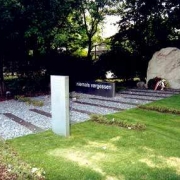Satellite Camp Jedlesee
Establishment of the satellite camp
During the evacuation of the Schwechat-Heidfeld concentration camp on 13 July 1944, the prisoners were first transferred to Wien-Floridsdorf Subcamp and then later on to the Hinterbrühl Subcamp and the Schwechat-Santa Subcamp. Those prisoners that remained in Floridsdorf were split up among the Hofherr & Schrantz detachment, AFA, and Jedlesee. The latter were housed separately from the others.
Location
It is difficult to find out exactly where the subcamps were located in what is today Vienna’s district of Floridsdorf because there were other camps in the former area of “Groß-Wien” that ran under the name of “Floridsdorf”. It can be safely assumed that the workplace of the prisoners was in Wien-Floridsdorf, Shuttleworthstraße 8, at Hofherr & Schrantz. The prisoner camp was on what today is the football field of the FAC club, approx. 500 metres away from their workplace. The AFA works in Floridsdorf were the leading supplier of submarine and torpedo batteries. Just how significant the production of these batteries was for the German arms industry, is apparent from the visit of the NS Armaments Minister Albert Speer on 4 July 1944 at Jedlesee Subcamp. There was also a sub-detachment at “St. Georg brewery” in Hopfengasse 22, the same place where the command headquarters were located. This sub-detachment is assumed to have been Jedlesee Subcamp.
Prisoners
Due to the unconfirmed sources, the highest number of prisoners in the individual camps of this complex is hard to reconstruct. The highest number of the entire Wien-Floridsdorf complex (Floridsdorf I, Jedlesee, Schwechat-Santa, and Hinterbrühl) was, however, 2,737 prisoners. The majority of the prisoners at the Wien-Floridsdorf complex were from Poland and the Soviet Union.
Forced labor
Little is known about the life and working conditions of the prisoners at Floridsdorf Subcamp. The prisoners were used for work in the armaments production and in aircraft construction.
Guarding
During its existence, the Jedlesee Subcamp was under the command of SS Obersturmführer (Senior Assault Leader) Anton Streitwieser, who also had command over Floridsdorf I (Hofherr & Schrantz and AFA), Hinterbrühl, and Schwechat (Santa). The headquarters of the military command of the entire Wien-Floridsdorf complex were in the former St. Georg brewery, Hopfengasse 22.
Closure
Jedlesee Subcamp, just like the Hofherr & Schrantz as well as the AFA detachment, was evacuated on 1 April, which suggests that the evacuation did not go through Hinterbrühl Subcamp. The evacuation march, which led through Steyr subcamp, reached Mauthausen Concentration Camp on 11 April 1945. According to the camp's typist’s office, 121 prisoners were murdered during the said march; 22 remain missing or managed to escape. The total number of deaths at Floridsdorf camp alone, seems to have been 45.
Commemoration and remembrance
Part of the Vienna city expressway now leads over where the Mautner brewery in Jedlesee used to be. A memorial plaque outside the Floridsdorf district museum serves as a reminder of the former subcamp. On the premises of the former barracks camp, there is now a football field. On the former grounds of the AFA works, there is a business park. The “Niemals vergessen” [1] society organises an annual commemoration ceremony in Floridsdorf. Information on it can be found in the programme for commemoration and liberation ceremonies [2].

